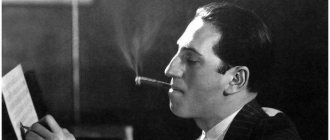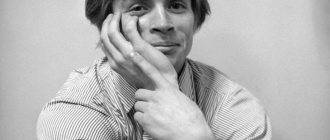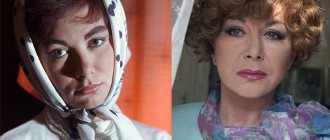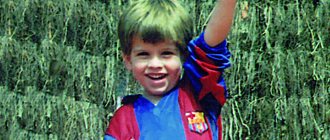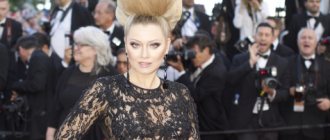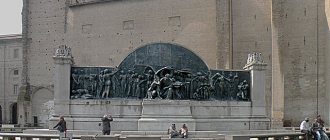Childhood and youth
Niccolo Paganini was born on October 27, 1782 in a small quarter of Italian Genoa called “Black Cat” in the family of Antonio Paganini and his wife Teresa. He turned out to be the second child and was very sickly from early childhood.
Once in a dream, Niccolo’s mother, who was a very sentimental woman, saw an angel in her dream who predicted her son’s future as a great musician. Since childhood, his parents forced him to play the violin, especially since his older brother Carlo was not particularly talented in this matter. Therefore, Niccolo had to take the rap for two. All his early years were devoted to monotonous learning the art of playing this musical instrument.
Nature has rewarded the Italian with a huge gift - the finest hearing, capable of picking up the smallest details in sound. Every day the boy discovered the world around him with the help of numerous musical tones, which he perceived with particular acuteness. He tried to reproduce them on a magdalene, a guitar or on his favorite little violin, which over time turned into a part of the musician’s soul.
The father discovered his son's talent early, counting on him winning fame and fortune. Therefore, little Niccolo was forced to play in the closet, constantly improving his skills. For the slightest sins, the child was deprived of food. All this negatively affected the boy’s fragile health. Already at the age of 8, Paganini wrote a violin sonata and several trumpet variations. Over time, the talented musician attracted attention, and he was noticed by the first violinist of the local choir, D. Kosto, who began to study with the young talent. Within six months, he passed on invaluable experience to his student, which allowed him to appear on stage for the first time.
An extraordinary gift
As if compensating for the child’s physical weakness, nature generously rewarded him with perfect, extremely sensitive hearing. While studying music, Niccolo Paganini, whose photo you see in our article, discovered a new world, painted with extraordinary colors. He tried to recreate it, playing the guitar, the mandolin and the little violin that was both his best friend and his tormentor.
The father recognized his son's abilities early. Every day he understood more and more clearly that his son was endowed with enormous talent, which would later lead to fame and big money. He understood perfectly well that his time in studying with his son was over and the time had come to hire professional musicians. To ensure that classes took place almost constantly, the little musician was locked in a dark closet, and his father carefully ensured that the music flowed continuously. For disobedience, the child was deprived of food. Such activities undermined the boy’s already fragile health.
First concerts
The musician's first public performance took place in May 1795 at the local theater of Sant'Agostino, the funds from which were to go towards a trip to Parma to study with the famous violinist A. Rolla. Here his “Variations on a Theme of Carmagnola” were performed, which were a success with the public. Soon a similar concert was given in Florence, which added the missing money. So Paganini’s father and son ended up in Parma with A. Rolla, but he was sick and did not want to accept anyone.
While waiting for the master, the boy took the violin that was lying in the next room and played Roll's recently written work on it, to the latter's admiration. He stated that he would not teach the teenager anything and advised him to contact F. Paer, but he, busy with musical productions, introduced Paganini to the talented cellist G. Ghiretti, who became his new mentor. He forced his student to create works without an instrument, relying only on his inner ear.
In 1797, Niccolo and his father went on their first concert tour of Europe. Their route ran through Milan, Florence, Pisa, Bologna and Livorno. His performances, which were a huge success in every city, inspired the musician to new achievements. It was during this time that he wrote most of his famous 24 Caprices, in which he demonstrated the greatness of his artistic imagination. The unusual interweaving of mind-blowing virtuosity with grotesque images and powerful dynamics made his musical works inimitable.
Creation
The meeting with Giacomo turned out to be fateful. New horizons opened up for the talented young man. At a young age, he already began giving his first concerts, impressing the audience with his playing of the instrument.
Meanwhile, the elder Paganini, realizing that he could make good money from his son’s extraordinary talent, became his impresario and began preparing his tour of Northern Italy. Concerts of the gifted violinist took place in Milan, Pisa, Bologna, Livorno, and Florence, and invariably sold out.
By that time, Niccolo had already created his masterpiece capriccios, thereby making a real revolution in violin music. He managed to achieve incredible expressiveness and artistic power in his works, which aroused genuine delight in the listener.
Endlessly tired of his cruel despot father, the matured Niccolo began an independent life. Feeling free for the first time, he began performing concerts not only in his native Italy, but also in many European countries.
Paganini managed to make a breakthrough in the art of violin playing. He amazed the audience with his filigree technique, using techniques such as playing on two and even one string. His innovations were so technically complex that they were long thought to be impossible to replicate. The maestro wrote music not only for the violin, but also for the guitar.
A brief biography of Paganini states that he loved the violin so much that throughout his life he collected instruments of famous violin makers. Niccolo bequeathed his instrument to his native Genoa, where it is kept to this day.
Independent life
The fame that befell the young man began to be burdened by the influence of his father, and at the first opportunity Niccolo left his parental home, becoming the first violinist in Lucca. He passionately devotes himself to his work, leading the city orchestra and giving concerts at the same time. At this time, the musician begins to enjoy many of the joys of life, playing cards and indulging in love. Infatuated with a certain “Senora Dide,” he even leaves touring for several years, only “feeling the strings of the guitar with pleasure.”
In 1804, Paganini returned to creativity, but the very next year he began to serve as court violinist in Lucca. F. Bacciocchi ruled here, whose wife was Napoleon's sister Princess Eliza, with whom the musician developed a passionate relationship. Since 1808, he resumed touring activities.
In 1814, Niccolo gives concerts in his homeland. Here he is greeted with great warmth, calling him nothing less than a genius. The audience was amazed by the extraordinary ease of playing the violin and the virtuoso performance of complex parts. It is no coincidence that the musician was repeatedly invited to perform at the famous La Scala theater.
In 1821, Paganini again left concert activity due to a large bouquet of aggravated illnesses - rheumatism, tuberculosis, intestinal and stomach pain. This forces him to move to Pavia closer to the famous doctor S. Borda. Bloodletting, a strict diet and rubbing ointments did not help immediately. Due to a surge of weakness, the musician did not risk picking up the violin for a long time, and his only outlet was private lessons with the son of a Genoese merchant, young K. Sivori.
Having overcome illnesses, except for an “unbearable cough,” Paganini performed in Milan, Pavia and Genoa in 1824. A little later, the musician created new works - “Military Sonata”, “Polish Variations”, and with them three concertos for violin, the most famous of which was the second with the famous ronda “Campanella”.
Start of independent life
Niccolo’s Italian temperament and established character began to increasingly lead to conflicts and quarrels in the family. Complete dependence on the father becomes more and more tiring for the young man. He wants freedom. That is why, when he was offered the position of first violin in Lucca, he accepted the offer with joy and gratitude. He became the leader of the city orchestra. In addition, he had the opportunity to give concerts. He performs with great success in Milan, Pisa, and Livorno. The enthusiastic reception from the public is dizzying.
At the zenith of glory
In the period from 1828 to 1834, Paganini gave many concerts in the largest halls of the Old World. He is applauded by both the general public and a large galaxy of artists, including F. Chopin, R. Schumann, F. Schubert, G. Heine, I. Goethe. The Austrian composer F. Liszt generally called Niccolo’s playing a “supernatural miracle.” In later concerts, to the delight of the audience, he increasingly plays with guitar accompaniment.
During his stay in Vienna, Paganini composed “Variations on the Austrian Hymn” and planned to create his main masterpiece, “The Venetian Carnival”. In 1830, thinking about the future of his son, the musician acquired the title of baron, which would be inherited by his son.
In 1829-1831, Paganini toured Germany. In a year and a half, he gave more than a hundred concerts in 30 cities. Here he completed work on the 4th and 5th concerts, and also wrote the work “Love Gallant Sonata”. Then there was France, and again a huge success. Here Niccolo composes again, dedicating 60 variations of the folk song “Barucaba” to his friend Jermi, a serenade for guitar, violin and cello to his sister Dominica, and a sonata to the daughter of his patron de Negro.
Homecoming
In September 1834 he returned to Genoa, where he began working on publishing his works. He also participated in a number of concerts, performing for the first time at the Teatro Carlo Felice on November 30, 1834. The performance was a huge success - the gallery was crowded long before the musician appeared on stage.
Paganini remained in Genoa until 1836, after which he moved to Paris to found a casino. He suffered a setback which forced him to auction off his musical instruments. In December 1838 he left Paris to spend his last years in Nice.
Secrets and mysteries of Paganini
The musician often declared certain secrets of his performance, which he would reveal only after the end of his career. This is also related to his reluctance to publish his own writings, which supposedly could declassify his secret. Some particularly zealous spectators saw Satan on the musician’s shoulder during the performance, others saw him fly to heaven in a carriage along with his retinue.
He became the first to use violin playing by heart rather than by notes at concerts. Constant practice of playing musical instruments made it possible to develop phenomenal strength in the wrist muscles, so Paganini could easily break a porcelain plate with two fingers.
Niccolo was a virtuoso performer. Once, on a dare, he brilliantly conducted an opera, playing a two-string violin. And at Napoleon’s next birthday, he performed the sonata of the same name only on the fourth string. According to D.F. Oistrakh, the Paganini phenomenon lies in an extraordinary combination of talent, temperament and hard work, which made it possible to use psychophysiological qualities to the maximum.
After his death, the church opposed the burial of the musician’s remains in a Christian cemetery, since he refused to receive communion. The reason for this action of Paganini was clear - he claimed that he would not die and would live forever.
Interesting Facts
- At his concerts, Paganini staged such enchanting performances that the most impressionable listeners lost consciousness.
- During performances, Niccolo wielded the instrument so obsessively that even broken strings did not stop him.
- With his violin playing, the musician brilliantly imitated the playing of other instruments, human speech, and birdsong, for which he was nicknamed the “Southern Sorcerer.”
- Paganini flatly refused to compose Catholic psalms, as a result of which he constantly clashed with the clergy.
- The violinist suffered from a severe gambling addiction, and sometimes lost entire fortunes. He was able to get rid of the addiction only after the birth of an heir.
Previous
BiographiesBrief biography of Yuri Vladimirovich Andropov, personal life
Next
BiographiesBiography of Ushakov - briefly about Admiral Fedor Fedorovich (4th grade)
Personal life
Relationships with the female sex are one of the mysterious pages of his biography. Not much is known about his first novel. A certain lady, passionate about the guitar, took the young Paganini to her Tuscan castle, where he lived for several years. Then his fate brought him together with Napoleon’s older sister Eliza, who was the princess of Lucca and Piombino at the beginning of the 19th century. The musician was very pleased with his relationship with an ugly but noble woman, thanks to whose patronage he began to regularly appear at court.
After spending three years next to Eliza, Paganini received permission to leave her, and soon his fate brought him together with another sister of the emperor, Polina Bonaparte. Their romance was very stormy, passionate and short. Indulging in lovemaking in Turin's Stupingi Castle, they quickly lost interest in each other, and the flighty Polina quickly found a replacement musician.
And then young Angelina Cavanna appeared in Paganini’s life, because of whom he almost went to prison. The father of a girl who became pregnant by Niccolo accused him of kidnapping and raping his daughter. The court ordered the musician to pay a fine, but this could not change the fate of the child, who died a year and a half before the end of the trial.
The maestro's new passion was the singer Antonia Bianca, whom Paganini decided to teach to sing at the beginning of their acquaintance. In 1825, she would give birth to his heir, Achille, but relations with Antonia would only worsen. In his letters, Niccolo more than once mentioned the frenzy of his girlfriend, who could easily throw the case with the violin. Dealing with many women, the great musician managed to maintain his independence, fully justifying the once said phrase: “Freedom is the highest good for a man.”
Paganini: biography, personal life
Niccolo was passionate and ardent not only in music.
It was at this time that he met his first love, and his name disappeared from posters for almost three years. Several guitar compositions dedicated to the mysterious “Signora Dida” appear. In 1804, the musician returned to Genoa, where he focused only on composing. Then he returns again to Lucca, where Felice Baciocchi ruled, who at that time was married to Napoleon’s sister, Princess Elisa. The composer's relationship with the princess soon ceased to be purely official. Paganini writes and dedicates his “Love Scene” for two strings (“A” and “E”) to her. During the performance of the composition, other strings were removed. The work created a sensation. Then the princess wished that a piece for one string be written for her, and Paganini accepted the challenge. He creates the sonata “Napoleon” for one string “G”, which he triumphantly presented at the Court Concert.
Three years later, the relationship with Princess Eliza began to weigh heavily on Niccolo Paganini. The biography and personal life of the maestro is full of love affairs and scandals. However, he never experienced the same feelings that he felt for his first passion, a noble lady who was most likely older than him, for any other woman.
At the end of 1814, the maestro came to his homeland with concerts. All his performances
are taking place with unprecedented success. The newspapers call him a genius, regardless of whether he is an angel or a demon. Here he met another woman with whom he became passionately interested - the daughter of a tailor, Angelina Cavanna. He took the girl with him to Parma. Very soon it became clear that she would have a child, and Paganini secretly sent her to his friends in the suburbs of Genoa.
In May of the same year, the father took Angelina and sued Paganini. The trial lasted two years. Angelina gave birth to a child. Unfortunately, he died soon after. The court decided to pay the girl three thousand lire.
The last chord
Paganini's contemporaries wrote that after the concerts the musician experienced convulsions similar to an epileptic seizure - his muscles cramped, his body temperature dropped, and his pulse froze. Niccolo himself called this state “electricity” that appeared in him and which “painfully torments, but comes out of me at the concert with divine harmony.” The first signs of a serious illness began to actively appear in 1834, which is why the maestro interrupted his performances. Two years later he plays several concerts in Nice, after which he becomes very ill.
Shortly before his death, Paganini, in very serious condition, visited his native Genoa.
The last six months of his life he was extremely exhausted, so he could not hold a bow in his hands. His beloved violin was left without a magic wand, and the musician plucked its strings with weakened fingers. The great composer and musician died on May 27, 1840 in Nice. At first, the church prevented his burial in Italy. Permission was received only in 1876, after which Paganini’s ashes were reburied in Parma.
Study in Parma
By early 1795, Niccolò Paganini had established himself as a renowned musician in his hometown, usually playing his own compositions at concerts. The local musicians had nothing more to teach him. Realizing this, his father decided to take him to Parma to Alessandro Rolla.
To go and stay in Parma, money was needed, but the family did not have it. Therefore, his father forced him to practice even more so that he could raise enough money at a charity concert that took place at the Teatro San Agostino in July 1795. The performance was successful, which allowed Antonio and Niccolò Paganini to leave for Parma in 1796.
When they reached Roll's house, they found that the owner was sick and lying in bed. While they were waiting for him, the boy noticed a musical instrument and a composition lying nearby. Taking the violin, Niccolo Paganini began to play. Rolla, although very ill, was amazed by his performance and told the teenager that he had nothing to offer. However, he gave him lessons for several months, and then suggested that he study composition with Ferdinando Paer and counterpoint with Gasparo Ghiretti.
Niccolo studied for six months. Under Paer's direction he wrote 24 figures for four hands, and while studying with Ghiretti he wrote a huge amount of instrumental music. Niccolò also gave a number of concerts, both in Parma and Colorno, earning himself fame and money.
In cinema
- Das Dreimäderlhaus (1918). Germany. Rayol Lang
- "Paganini", produced in Germany, starring Conrad Veidt, 1923.
- Franz Schuberts letzte Liebe (1926) Germany. Otto Schmuhl.
- Die lachende Grille (1926) Germany. Hans Washatko.
- Paganini in Venedig (1929) Germany. Andreas Weisgerber.
- Gern hab' ich die Frau'n geküßt (1934) Germany. Ivan Petrovich.
- Casta diva (1935) Italy. Gualtiero Tumiati.
- The Divine Spark (1935) England. Hugh Miller
- Fantastic symphony / La symphonie fantastique (1942) France. Maurice Schultz.
- Rossini / Rossini (1942) Italy. Cesare Fantoni.
- Heavenly Music (1943) USA. Fritz Feld
- A Song to Remember (1945) USA. Roxy Roth.
- The Magic Bow (1946) England. Stuart Granger.
- Housle a sen (1947): Bohemian Rapture (1948) Czechoslovakia. Karel Got it.
- Chopin's youth / Mlodosc Chopina (1952) Poland. Frantisek Jamry.
- Casta diva (1956) Italy - France. Danilo Berardinelli.
- The acquittal of Paganini (1969, USSR). Vsevolod Yakut
- Paganini / Paganini (1973) (Germany) Antonio Teba.
- Paganini / Paganini (1976) (Italy) Tino Shirinzi.
- Niccolo Paganini, USSR-Bulgaria, 1982 (Information about the film) Starring Vladimir Msryan
- Spring Symphony / Frühlingssinfonie (1983) Germany. Gidon Kremer.
- Zygfried (1986) Poland. Krystof Stopa.
- Paganini Horror is an Italian horror film (1989). Luigi Cozzi.
- "Paganini", produced in Italy - France, 1989. Starring Klaus Kinski.
- Napoleon (2002) England - France. Portrayed by Yulian Rakhlin.
- Moi, Hector Berlioz (2003) France. Claude Josto.
- Paganini: The Devil's Violinist (2013) Germany, Italy. Starring violin virtuoso David Garrett.
The beginning of a concert career
The biography of Paganini notes that his first concert tour took place in 1797. It took place in several Italian cities, including Milan and Florence. After the tour, he and his family went to his father’s house in the Polchevera Valley, where he practiced on his own, trying to bring his playing technique to perfection.
In December 1801, he got rid of his father's tutelage, receiving the position of first violin of the orchestra of the city of Lucca. In this city, Niccolo falls in love with a noble lady. Soon they leave for her estate. He lived there for three years, farming and playing the guitar; he wrote 12 sonatas for her in a duet with the violin. In the first years of independent life, he had two passions - women and card games. Nikkola could have lost everything. Only music made it possible to improve my financial condition later.
Resumption of concert activities
In April, one thousand eight hundred and twenty-four, Niccolo, unexpectedly for everyone, comes to Milan and announces his desire to give a concert. Then he gives a concert in Pavia and Genoa. At this time, he resumes his relationship with his former mistress Antonia Bianchi, who by that time had become a famous singer who had success at La Scala. They have a son, Achilles. Paganini works a lot. At this time, new works appeared - “Military Sonata”, “Polish Variations”, “Companella”. The second violin concerto in B minor becomes the culmination of the musician’s creativity. After him, he did not create anything more light, exciting and joyful.
Paganini's biography consists of an interweaving of happy and tragic events. In the spring of 1830, the great musician gave a concert in Westphalia and received the title of baron there, which is inherited.
In October, one thousand eight hundred and thirty-nine, Niccolo Paganini visited his native Genoa for the last time in his life. He already feels very bad. For the last five months of his life, he cannot leave the house, his legs are very swollen, and he is so exhausted that he is unable to pick up a bow. His favorite violin lay next to him, and he fingered its strings.
The great musician, composer, virtuoso performer died in Nice on May twenty-seventh, one thousand eight hundred and forty at the age of fifty-eight.
Today we introduced you to the life of Nicolo Paganini. The biography briefly outlined in this article, of course, cannot give a complete picture of this bright and extraordinary personality.
In art
- Anatoly Vinogradov.
book “The Tale of the Turgenev Brothers. Condemnation of Paganini." — Minsk: Second-hand book edition. Mastatskaya literature, 1983. - (1936 novel “The Condemnation of Paganini”). - Elena Vorobyova.
book “Chronicles of Arvanda. Legends of the Sleeping City. - SPb.: ITD "SKYTHIA", 2010. - (play “The Burnt Road by Niccolo Paganini”). 2. - Tatiana Burford.
book “Nicolo Paganini. Stylistic origins of creativity." - St. Petersburg: Publishing house named after N.I. Novikov, 2010. - (Abstract). - The fourth album of the rock band Aria is called Playing with Fire. The song, which became the title track for the album, talks about how Paganini sold his soul to the devil for his virtuoso playing.
- The Czech group XIII stoleti dedicated the song Upir s houslemi to N. Paganini.
Childhood
From early childhood, Niccolo was a fragile and sickly child. Health problems were aggravated by the characteristics of his childhood.
Father - Antonio Paganini, was an amateur musician. When his hopes for the musical career of his eldest son Carlo collapsed, he transferred them to Niccolo. He, unlike his brother, discovered unique musical abilities from an early age. Niccolo Teresa’s mother’s prophetic dream added fuel to the fire. She saw an angel who predicted a brilliant musical career for her son. As a result, Niccolo was practically deprived of an ordinary childhood. All his days were spent in continuous exercise. The father followed this fanatically and strictly, and even deprived his son of food until he finished learning the next sketch.
Nature has endowed Niccolo with the finest hearing. In addition to his favorite violin, the boy also played the mandolin and guitar well. Already at the age of 8, he began writing music, writing a sonata and variations for violin. Since 1793, Niccolo began to play at services in local churches. Soon the father realized that professionals should take care of his son. They were Giovanni Cervetto, Francesco Gnecco and Giacomo Costo. Classes with them prepared the boy for his first concert in 1895.
short biography
Niccolo Paganini
(Italian Niccolò Paganini; October 27, 1782, Genoa - May 27, 1840, Nice) - a great Italian virtuoso violinist and composer.
early years
Niccolo Paganini was the third child in the family of Antonio Paganini (1757-1817) and Teresa Bocciardo, who had six children. His father was at one time a loader, later had a shop in the port, and during the census of Genoa, carried out on the orders of Napoleon, he was named “mandolin holder.”
When the boy was five years old, his father, noticing his son’s abilities, began teaching him music, first on the mandolin, and from the age of six on the violin. According to the recollections of the musician himself, his father severely punished him if he did not show due diligence, and this subsequently affected his already poor health. However, Niccolo himself became more and more interested in the instrument and worked hard, hoping to find yet unknown combinations of sounds that would surprise listeners.
As a boy, he wrote several works (not preserved) for the violin, which were difficult, but he himself successfully performed them. Soon Niccolo's father sent his son to study violinist Giovanni Cervetto
). Paganini himself never mentioned that he studied with Cervetto, but his biographers, for example Fetis, Gervasoni, mention this fact. Since 1793, Niccolò began to regularly play at services in Genoese churches. At that time, in Genoa and Liguria, a tradition developed in churches to perform not only sacred, but also secular music. One day he was heard by composer Francesco Gnecco, who began to advise the young musician. In the same year, he studied with Giacomo Costa, who invited Niccolò to play in the Cathedral of San Lorenzo, of which he was conductor. It is not known whether Paganini attended school; perhaps he learned to read and write later. His letters, written in adulthood, contain spelling errors, but he had some knowledge of literature, history, and mythology.
Niccolo gave his first public concert (or, as they said then, academy) on July 31, 1795 at the Genoese theater of Sant'Agostino. The proceeds from him were intended for Paganini’s trip to Parma to study with the famous violinist and teacher Alessandro Rolla. The concert included Niccolo’s composition “Variations on a Theme of Carmagnola,” a piece that could not help but please the Genoese public, which was pro-French at that time. In the same year, the philanthropist Marquis Gian Carlo Di Negro took Niccolo and his father to Florence. Here the boy performed his “Variations...” to violinist Salvatore Tinti, who, according to the first biographer of the musician Conestabile, was amazed by the incredible skill of the young musician. The concert given by Niccolò at the Florence theater made it possible to raise the missing funds for the trip to Parma. On the day when father and son Paganini visited Rolla, the latter was ill and did not intend to receive anyone. In the room next to the patient’s bedroom, on the table were the sheet music of a concert written by Rolla and a violin. Niccolo took the instrument and played from the sheet the piece he had created the day before. Surprised, Rolla came out to the guests and, seeing that a boy was playing his concert, declared that he could no longer teach him anything. According to the composer, Paganini should have consulted Ferdinando Paer. The paer, busy staging operas not only in Parma, but also in Florence and Venice, having no time for lessons, recommended the young violinist to cellist Gaspare Ghiretti. Ghiretti gave Paganini lessons in harmony and counterpoint; during these lessons, Niccolo, under the guidance of the teacher, composed, using only pen and ink, “24 four-voice fugues.” In the fall of 1796, Niccolò returned to Genoa. Here, in the house of the Marquis Di Negro, Paganini performed the most complex pieces from sight at the request of Rodolphe Kreutzer, who was on a concert tour. The famous violinist was amazed and “predicted extraordinary fame for this young man.”
At the beginning of 1797, Paganini and his father undertook their first concert trip; their route included Milan, Bologna, Florence, Pisa, and Livorno. In Livorno, Niccolò gave few concerts; the rest of the time he devoted to improving his technique and practiced independently without teachers. According to him, in this city he wrote music for the bassoon at the request of a Swedish amateur musician who complained about the lack of difficult works for this instrument. Due to hostilities, the tour had to be interrupted, Paganini returned to Genoa, and soon, together with his entire family, he left for a house that belonged to his father in the Polchevera Valley. Here he began to improve his performing and composing skills. Paganini invented for himself and performed complex exercises similar to those of the 17th century violinist Walter. Having adopted the techniques of the masters of the past, Paganini tirelessly improved in the performance of transitions, staccato, pizzicato (including scales, simple and double trills and harmonics), unusual chords, dissonances, and strove for the correct extraction of sounds at the highest speed. He performed the exercises for many hours a day until he was completely exhausted.
Start of an independent career. Lucca
In 1801, his father's guardianship over Paganini was terminated. He resumed his concert activities in December 1800 in Modena. His fame as an outstanding violinist grew extraordinary. In the autumn of 1801 he arrived in Lucca. Paganini's two performances in Lucca Cathedral were enthusiastically received by the public. In the local handwritten journal "Lucca Literary Mixture" Paganini, called the "Genoese Jacobin", was paid tribute as a master, but the author of the message pointed out with disapproval that the cathedral had no place for imitation of bird singing, the sound of a flute, horn, trumpet, which so amazed those gathered that “everyone laughed, admiring the skill and fluency of the instrument.” In December 1801, Paganini received the position of first violin of the Lucca Republic. He spent several years in this city. According to the son of the composer Domenico Quilici, Bartolomeo, Paganini was also involved in teaching in Lucca and worked with orchestra musicians. Probably Paganini's most serious love interest is associated with the Lucca period. A noble lady, whose name the musician hid all his life, retired with him to her Tuscan estate. Paganini lived there for three years, farming. During his years of seclusion, he became addicted to playing the guitar and wrote 12 sonatas for this instrument and violin (Op. 2 and 3). According to the recollections of Paganini himself, during the first period of his independent life, in addition to his passion for women, he was possessed by a love of card games. Often he lost everything, and “only my own art could save me,” but he managed to give up gambling and never touched cards again. Paganini left Lucca for a short time and returned to Genoa. He was invited back to Tuscany by Elisa Bonaparte, who, thanks to her brother, became the princess of Piombino, Lucca, Massa, Carrara and Gargnafo. Paganini received the title of “court virtuoso” and at the same time was appointed captain of the princess’s personal guard. For a small salary, he acted as the princess's personal musician, conducted performances, regularly organized concerts and gave violin lessons to the prince. According to Paganini himself, he was having an affair with Eliza at that time.
1808-1812. Turin, Florence
In 1808, Paganini received a long leave and went with concerts around Italy. Gradually, he developed his own performing style, different from other violinists. His unusual appearance and behavior during concerts brought him fame. The halls at his performances were filled not only with connoisseurs of high art, but also with the public, attracted by the external effects and incredible playing techniques that Paganini demonstrated. He behaved emphatically mysteriously and at first did not stop the most fantastic rumors about himself from being spread. Before one of the concerts in Livorno, he injured his leg and limped onto the stage. There was laughter in the hall, and when the candles fell from the music stand, they turned into friendly laughter. Paganini, maintaining a calm expression, began to play, but suddenly a string on the violin broke, without stopping he continued the concert and received thunderous applause. It was not new for him to play not only three, but also two, and even one string. Thus, while serving at the court of Eliza Bonaparte, he wrote and performed the play “Love Scene” for the A and E strings, and later, for the emperor’s birthday, the sonata for the G string “Napoleon”. Paganini spent some time at the Turin court of Pauline Bonaparte. Here he became friends with the musical director of the Princess Borghese, Felice Blangini. Blangini became one of Paganini's most ardent admirers. In one of his letters to friends in Paris, he speaks of Niccolo as follows:
“No one can express in words the charm that his noble performance evokes. No one ever dared to even dream that one could hear something like that in reality. When you look at him, listen to him, you involuntarily cry or laugh, you involuntarily think about something superhuman. He only has a violin and a bow in common with other violinists.”
In the second half of 1808, Paganini, at the invitation of Eliza Bonaparte, came to Florence. Luigi Picchianti told Paganini's first biographer, Conestabile, about an incident that occurred during the musician's stay in Florence that fully demonstrated his exceptional skill. Paganini was supposed to perform Haydn's Sonata in the house of one of the courtiers, accompanied on the piano. The musician was very late, and when he arrived, without making the listeners wait any longer, he began to play without checking the tuning of the violin. He played superbly, introducing improvised flourishes at his own discretion. After the first part of the work, Paganini discovered that the “A” on the violin differs from the “A” on the piano by a whole tone. Picchianti, who was well versed in music, by his own admission, was amazed: Paganini, in order to correctly perform the “Sonata” with such an arbitrary violin tune, had to instantly redo the entire fingering, but the listeners did not notice anything.
At the end of 1812, he left the court service that was weighing him down and left Florence.
Foreign tours
Around 1813, the musician was present at La Scala at one of the performances of Viganò-Süssmayer's ballet The Nut of Benevento. Inspired by the scene of the unrestrained dancing of the witches, which struck his imagination, Paganini wrote a composition that became one of the most famous in his work - “The Witches,” variations on the theme of the ballet “The Walnut of Benevento” for violin and orchestra (Variations on the fourth string).
The work premiered at his solo concert at La Scala on October 29, 1813. The Milan correspondent of the Leipzig music newspaper reported that the audience was deeply shocked: the variations on the fourth string amazed everyone so much that the musician repeated them at the insistent demand of the public. Following this, Paganini gave eleven concerts over the course of six weeks at La Scala and the Carcano Theater, and the variations entitled “The Witches” were invariably a particular success.
Paganini's fame increased after traveling through Germany, France and England. The musician enjoyed enormous popularity everywhere. In Germany, he bought the title of baron, which was inherited.
On December 27, 1808, in the Masonic lodge of the Grand East, Paganini performed a Masonic hymn, written by him to the words of Lancetti. The lodge protocols confirm Paganini's Freemasonry.
At the age of 34, Paganini became interested in the 22-year-old singer Antonia Bianchi, whom he helped prepare for a solo performance. In 1825, Niccolo and Antonia had a son, Achilles. In 1828, the musician broke up with Antonia, having achieved sole custody of his son.
Working hard, Paganini gave concerts one after another. Wanting to provide his son with a decent future, he asked for huge fees, so that after his death his inheritance amounted to several million francs.
Constant touring and frequent performances undermined the musician’s health. In September 1834, Paganini decided to end his concert career and returned to Genoa. He was constantly ill, but at the end of December 1836 he performed three concerts in Nice.
Throughout his life, Paganini had many chronic diseases. Although no definitive medical evidence exists, it is believed that he had Marfan syndrome. Despite the fact that the violinist resorted to the help of eminent doctors, he could not get rid of his ailments. In October 1839, sick and in an extremely nervous state, Paganini came to his native Genoa for the last time.
The last months of his life he did not leave the room, his legs constantly hurt, and his illnesses were no longer treatable. The exhaustion was so severe that he could not pick up a bow; his strength was only enough to finger the strings of the violin lying next to him.
Niccolo Paganini died in Nice on May 27, 1840, 5 months before his 58th birthday.
